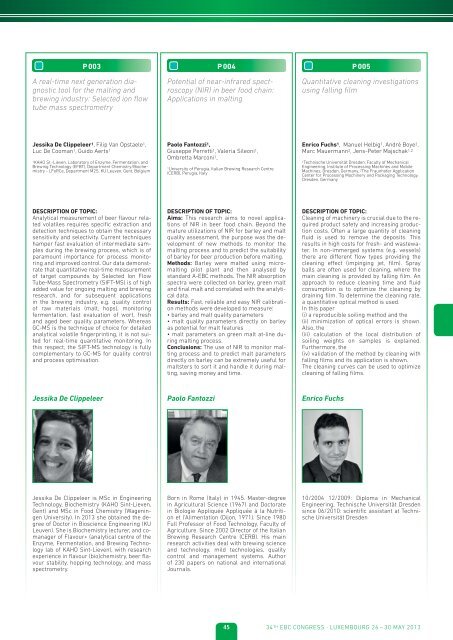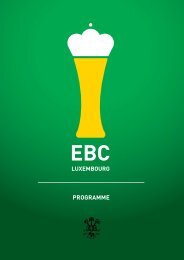please click here for download. - the 34th European Brewery ...
please click here for download. - the 34th European Brewery ...
please click here for download. - the 34th European Brewery ...
You also want an ePaper? Increase the reach of your titles
YUMPU automatically turns print PDFs into web optimized ePapers that Google loves.
P 003<br />
A real-time next generation diagnostic<br />
tool <strong>for</strong> <strong>the</strong> malting and<br />
brewing industry: Selected ion flow<br />
tube mass spectrometry<br />
P 004<br />
Potential of near-infrared spectroscopy<br />
(NIR) in beer food chain:<br />
Applications in malting<br />
P 005<br />
Quantitative cleaning investigations<br />
using falling film<br />
Jessika De Clippeleer 1 , Filip Van Opstaele 1 ,<br />
Luc De Cooman 1 , Guido Aerts 1<br />
1KAHO St.-Lieven, Laboratory of Enzyme, Fermentation, and<br />
Brewing Technology (EFBT), Department Chemistry/Biochemistry<br />
- LFoRCe, Department M2S, KU Leuven, Gent, Belgium<br />
Paolo Fantozzi 1 ,<br />
Giuseppe Perretti 1 , Valeria Sileoni 1 ,<br />
Ombretta Marconi 1 ,<br />
1University of Perugia, Italian Brewing Research Centre<br />
(CERB), Perugia, Italy<br />
Enrico Fuchs 1 , Manuel Helbig 1 , André Boye 2 ,<br />
Marc Mauermann 2 , Jens-Peter Majschak 1,2<br />
1Technische Universität Dresden, Faculty of Mechanical<br />
Engineering, Institute of Processing Machines and Mobile<br />
Machines, Dresden, Germany, 2 The Fraunhofer Application<br />
Center <strong>for</strong> Processing Machinery and Packaging Technology,<br />
Dresden, Germany<br />
DESCRIPTION OF TOPIC:<br />
Analytical measurement of beer flavour related<br />
volatiles requires specific extraction and<br />
detection techniques to obtain <strong>the</strong> necessary<br />
sensitivity and selectivity. Current techniques<br />
hamper fast evaluation of intermediate samples<br />
during <strong>the</strong> brewing process, which is of<br />
paramount importance <strong>for</strong> process monitoring<br />
and improved control. Our data demonstrate<br />
that quantitative real-time measurement<br />
of target compounds by Selected Ion Flow<br />
Tube-Mass Spectrometry (SIFT-MS) is of high<br />
added value <strong>for</strong> ongoing malting and brewing<br />
research, and <strong>for</strong> subsequent applications<br />
in <strong>the</strong> brewing industry, e.g. quality control<br />
of raw materials (malt, hops), monitoring<br />
fermentation, fast evaluation of wort, fresh<br />
and aged beer quality parameters. W<strong>here</strong>as<br />
GC-MS is <strong>the</strong> technique of choice <strong>for</strong> detailed<br />
analytical volatile fingerprinting, it is not suited<br />
<strong>for</strong> real-time quantitative monitoring. In<br />
this respect, <strong>the</strong> SIFT-MS technology is fully<br />
complementary to GC-MS <strong>for</strong> quality control<br />
and process optimisation.<br />
DESCRIPTION OF TOPIC:<br />
Aims: This research aims to novel applications<br />
of NIR in beer food chain. Beyond <strong>the</strong><br />
mature utilizations of NIR <strong>for</strong> barley and malt<br />
quality assessment, <strong>the</strong> purpose was <strong>the</strong> development<br />
of new methods to monitor <strong>the</strong><br />
malting process and to predict <strong>the</strong> suitability<br />
of barley <strong>for</strong> beer production be<strong>for</strong>e malting.<br />
Methods: Barley were malted using micromalting<br />
pilot plant and <strong>the</strong>n analysed by<br />
standard A-EBC methods. The NIR absorption<br />
spectra were collected on barley, green malt<br />
and final malt and correlated with <strong>the</strong> analytical<br />
data.<br />
Results: Fast, reliable and easy NIR calibration<br />
methods were developed to measure:<br />
• barley and malt quality parameters<br />
• malt quality parameters directly on barley<br />
as potential <strong>for</strong> malt features<br />
• malt parameters on green malt at-line during<br />
malting process.<br />
Conclusions: The use of NIR to monitor malting<br />
process and to predict malt parameters<br />
directly on barley can be extremely useful <strong>for</strong><br />
maltsters to sort it and handle it during malting,<br />
saving money and time.<br />
DESCRIPTION OF TOPIC:<br />
Cleaning of machinery is crucial due to <strong>the</strong> required<br />
product safety and increasing production<br />
costs. Often a large quantity of cleaning<br />
fluid is used to remove <strong>the</strong> deposits. This<br />
results in high costs <strong>for</strong> fresh- and wastewater.<br />
In non-immerged systems (e.g. vessels)<br />
t<strong>here</strong> are different flow types providing <strong>the</strong><br />
cleaning effect (impinging jet, film). Spray<br />
balls are often used <strong>for</strong> cleaning, w<strong>here</strong> <strong>the</strong><br />
main cleaning is provided by falling film. An<br />
approach to reduce cleaning time and fluid<br />
consumption is to optimize <strong>the</strong> cleaning by<br />
draining film. To determine <strong>the</strong> cleaning rate,<br />
a quantitative optical method is used.<br />
In this paper<br />
(i) a reproducible soiling method and <strong>the</strong><br />
(ii) minimization of optical errors is shown.<br />
Also, <strong>the</strong><br />
(iii) calculation of <strong>the</strong> local distribution of<br />
soiling weights on samples is explained.<br />
Fur<strong>the</strong>rmore, <strong>the</strong><br />
(iv) validation of <strong>the</strong> method by cleaning with<br />
falling films and its application is shown.<br />
The cleaning curves can be used to optimize<br />
cleaning of falling films.<br />
Jessika De Clippeleer<br />
Paolo Fantozzi<br />
Enrico Fuchs<br />
Jessika De Clippeleer is MSc in Engineering<br />
Technology, Biochemistry (KAHO Sint-Lieven,<br />
Gent) and MSc in Food Chemistry (Wageningen<br />
University). In 2013 she obtained <strong>the</strong> degree<br />
of Doctor in Bioscience Engineering (KU<br />
Leuven). She is Biochemistry lecturer, and comanager<br />
of Flavour+ (analytical centre of <strong>the</strong><br />
Enzyme, Fermentation, and Brewing Technology<br />
lab of KAHO Sint-Lieven), with research<br />
experience in flavour (bio)chemistry, beer flavour<br />
stability, hopping technology, and mass<br />
spectrometry.<br />
Born in Rome (Italy) in 1945. Master-degree<br />
in Agricultural Science (1967) and Doctorate<br />
in Biologie Appliquée Appliquée à la Nutrition<br />
et l‘Alimentation (Dijon, 1971). Since 1980<br />
Full Professor of Food Technology, Faculty of<br />
Agriculture. Since 2002 Director of <strong>the</strong> Italian<br />
Brewing Research Centre (CERB). His main<br />
research activities deal with brewing science<br />
and technology, mild technologies, quality<br />
control and management systems. Author<br />
of 230 papers on national and international<br />
Journals.<br />
10/2004 12/2009: Diploma in Mechanical<br />
Engineering, Technische Universität Dresden<br />
since 06/2010: scientific assistant at Technische<br />
Universität Dresden<br />
45 34 TH EBC CONGRESS · LUXEMBOURG 26 – 30 MAY 2013





